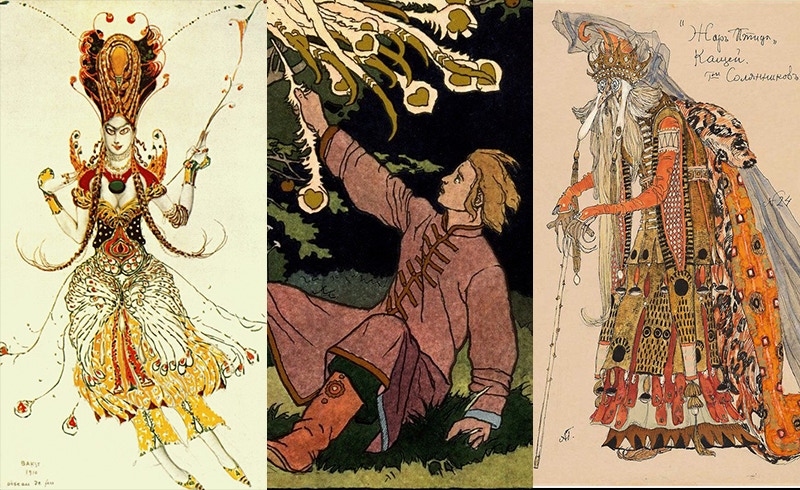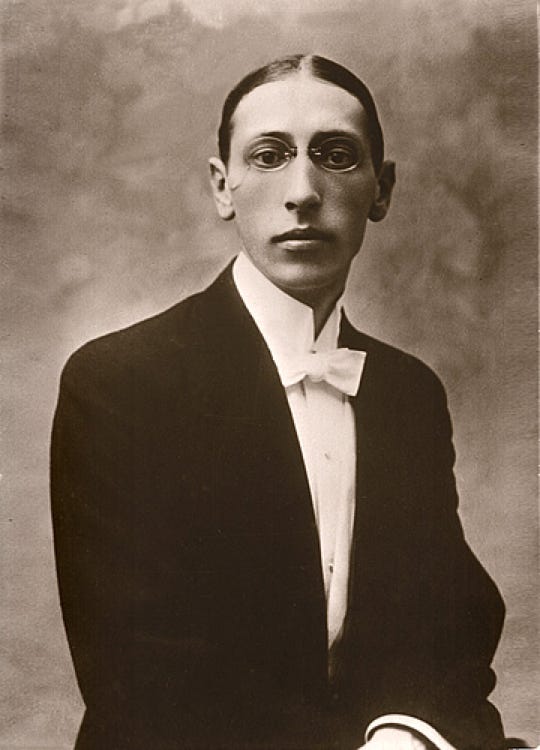
Stravinsky in 1910

Igor Stravinsky
1882-1971
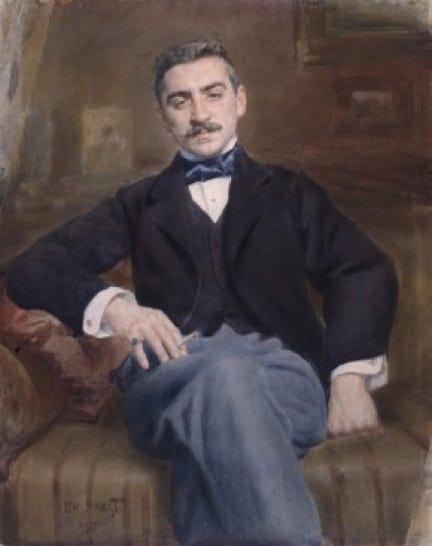
PROGRAM NOTES & COMMENTARY
The Firebird Suite (1919)
Genre: Symphonic; Country: Russia
Period: Early 20th century
Completed in 1919
Original ballet completed in 1910, first performance June 25, 1910, Paris
In 1909, Sergei Diaghilev, the Russian impresario, faced a time crunch. Following the sudden demise of a crucial supporter for his endeavors, Diaghilev had to abandon his initial plans to showcase Russian opera in Paris during the spring of 1910. Consequently, he opted for the more budget-friendly artistic expression of ballet. Diaghilev founded the Ballets Russes in 1909, which would become widely regarded as the most influential ballet company of the 20th century.
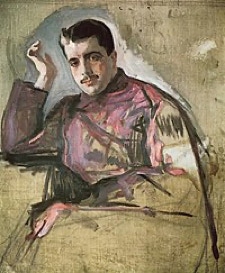
Stage design for the 1910 Ballets Russes Scheherazade, by Leon Bakst
Leon Bakst
Sergei Diaghilev
Prior to arriving in Paris, Diaghilev had led one of Russia's most influential artistic publications, Mir Iskusstva, meaning "The World of Art." This publication championed a hedonistic aestheticism under the banner of "art for art's sake," a stance criticized by opponents as decadence. The Miriskusniki, or adherents of this movement, favored stylization over realism, fairytales over social commentary, primal emotions and sensuality over detached rationality, and, above all, the pursuit of beauty over moralizing. Their ambitious vision involved crafting a comprehensive, seamlessly integrated work of art encompassing music, theater, and visual design—a creation both novel and deeply rooted in the essence of primal Russia. The Firebird, a character from Russian folklore symbolizing rebirth, beauty, and magic, served as their chosen mascot. Consequently, the centerpiece of Diaghilev's 1910 Paris season would be The Firebird, a groundbreaking ballet poised to embody his ideals and demonstrate that Russian art stood at the forefront of sophistication.
For The Firebird, Diaghilev originally planned to hire a composer with whom he had worked before, Alexander Tcherepnin, but he dropped out. Next Diaghilev turned to Anatoly Lyadov, but he also fell through, possibly because the project came at such short notice. Diaghilev briefly considered Alexander Glazunov, then Russia’s leading composer, but he didn’t bite. Running out of options, he turned to a young, relatively untested composer who had orchestrated two pieces by Chopin for a Diaghilev ballet the year before: Igor Stravinsky. A former student of the great Rimsky-Korsakov, Stravinsky would at least be technically proficient, and being little-known, he would likely say yes to anything.
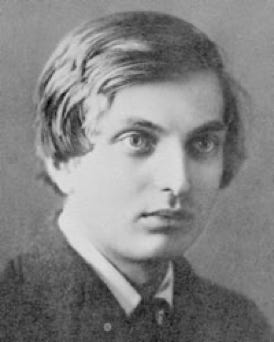
Tcherepnin: NO
Glazunov: NO
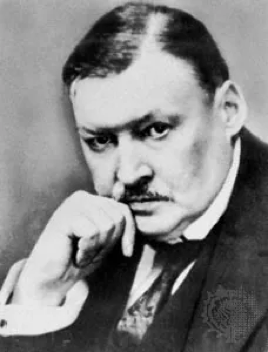

Liadov: NO

Stravinsky: YES!
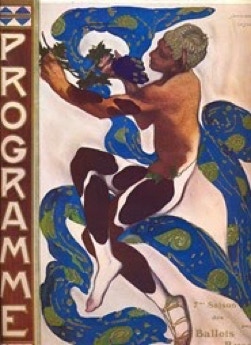
Program for Debussy’s Afternoon of a Faun, staged as a ballet by the Ballets Russes in Paris in 1912
The ballet's plot tells the story of Prince Ivan who, lost, finds himself in the enchanted garden of the evil Kostcheï. In the garden are Koschei's enemies petrified into statues. He sees and is smitten by The Firebird. Though he tries to grab her, she makes her escape but gives him one of her feathers and tells him to wield it if ever he is in difficulty.
Ivan continues towards Kostcheï's castle, where he lingers in the pleasurable company of the beautiful Tsarevna. Too long, it would seem, as Kostcheï appears, and tries to turn the Prince into stone. Ivan waves the feather, at which point The Firebird reappears. The Prince is instructed to hurl a giant egg, containing Kostcheï's soul, to the ground, causing Kostcheï to die. Ivan and Tsarevna marry, to great rejoicing.

Prince Ivan squares off against the evil King Kostcheï, with the Firebird, center
Diaghilev's insight proved accurate as Stravinsky immersed himself in the creative process even before receiving a formal offer from Diaghilev. However, many of Stravinsky's initial sketches had to be discarded due to the evolving details of the ballet's plot and structure. In a fervent effort to infuse the ballet with a distinctly Russian essence, Diaghilev's team crafted a narrative weaving together characters from a myriad of Russian fairytales. The amalgamation included the Firebird, Prince Ivan-Tsarevich, thirteen dancing princesses, and the malevolent sorcerer-king Kostcheï the Deathless. This unique cast drew inspiration from an excerpt in Polonsky's renowned poem, "A Winter's Journey," a verse still recited by Russian children today:
…And in my dreams I see myself on a wolf’s back
Riding along a forest path
To do battle with a sorcerer-tsar
In that land where a princess sits under lock and key,
Pining behind massive walls.
There gardens surround a palace all of glass;
There Firebirds sing by night
And peck at golden fruit…

Michel Fokine and Tamara Karasavina as Prince Ivan and the Firebird, photographed in 1910

Ivan Bilibin’s classic illustration of Prince Ivan and the Firebird
Stravinsky utilizes leitmotives in Firebird to symbolize the different characters in the story. In order to make the melody fit the surroundings and meaning of the story throughout the entire ballet, he alters it in subtle ways by varying the accompanying music.


Kostcheï’s Magic Garden and the statues

Kostcheï and his Infernal Dance

The triumph of Prince Ivan
The work was a colossal success and launched Stravinsky’s career as an international figure. Critical reception was generally very positive:
Rachmaninoff: “Great God! What a work of genius this is! This is true Russia!”
Myaskovsky: “What a wealth of invention, how much intelligence, temperament, talent, what a remarkable, what a rare piece of work this is.”
However:
Debussy: “What do you expect? One has to start somewhere.”
Richard Strauss: “It’s always interesting to hear one’s imitators.”
Prokofiev: “There was no music in the ballet’s introduction and if there was any, it was from (Rimsky-Korsakov’s opera) Sadko.”
A French critic reported his experience of hearing Stravinsky play through his work-in-progress in Saint Petersburg: “The composer, young, slim, and uncommunicative, with vague meditative eyes, and lips set firm in an energetic looking face, was at the piano. But the moment he began to play, the modest and dimly lit dwelling glowed with a dazzling radiance. By the end of the first scene, I was conquered: by the last, I was lost in admiration. The manuscript on the music-rest, scored over with fine pencilings, revealed a masterpiece.” Not too bad for a 28-year-old composer!
